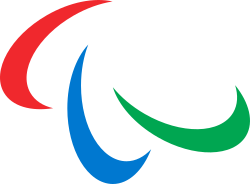Top Qs
Timeline
Chat
Perspective
Paralympic symbols
From Wikipedia, the free encyclopedia
Remove ads
The Paralympic symbols are the icons, flags, and symbols used by the International Paralympic Committee (IPC) to promote the Paralympic Games.
Motto
The current Paralympic motto is "Spirit in Motion". It was introduced at the 2004 Summer Paralympics.[1]
Symbol
Summarize
Perspective
Current
The symbol of the Paralympic Games consists of three red, blue, and green crescents encircling a single point on a white field.[1][2] It was modernized from the 1992 emblem by advertising agency Scholz & Friends[3] and was formally used for the first time during the closing ceremony of the 2004 Summer Paralympics.[4][3]
In October 2019, the IPC unveiled a new version of the emblem with a "stricter" geometry and brightened colours to match those used in the Olympic rings.[5][6]
Previous

The first Paralympic logo was created for the 1988 Summer Paralympics in Seoul and based on a traditional Korean decorative component called a pa, two of which make up the taegeuk symbol used in the flag of South Korea. The first Paralympic flag used five identically colored pas arranged similarly to the Olympic rings.[1][2]
In 1991, the International Olympic Committee (IOC) requested that the IPC modify its logo due to its similarity to the Olympic emblem.[1][2][7][8] As a result, a new Paralympic symbol utilizing only three pas was revealed at the 1992 Winter Paralympics.[7] It took effect after the 1994 Winter Paralympics and officially remained through the 2004 Summer Paralympics.[1][2]
Remove ads
Paralympic emblems
Like the Olympics, each Paralympic Games has a unique emblem[9] incorporating a version of the Paralympic symbol, the name and year of the event, and distinctive and cultural elements of the host nation. The emblems, once approved by the IPC, are used in promotional materials, by sponsors, and on Paralympic uniforms.
Flag
The Paralympic flag consists of the Paralympic symbol on a white background. The current version of the flag was first flown in 2019.
Flame and torch relay
Since the 1988 Summer Paralympics, the Paralympic torch was used to maintain energy and keep energy dissipated before the Paralympic games.
Until the 2010 Winter Paralympics, each Organizing Committee was free to choose which method and how the Paralympic torch would be lit.[10] Following the Games, calls emerged for a "heritage flame" to become a permanent tradition of the Paralympics.[11] In August 2013, a ceremonial heritage flame was lit during a ceremony at Stoke Mandeville Stadium,[12] and on October 2023, it was announced that future Paralympic torch relays would officially in begin Stoke Mandeville, in a direct parallel to the traditional Olympic flame lighting in Olympia.[13][14][15]
Remove ads
Medals
Paralympic medals are made of gold-plated silver, silver, or bronze and are awarded to the top 3 finishers in each event. They are designed differently for each Paralympic Games.
Anthem
The Paralympic Anthem, also known as the Paralympic Hymn, is played during the raising of the Paralympic Flag. The anthem, "Hymne de l’Avenir" (en. "Anthem of the Future"), was composed by Thierry Darnis.[16] It was approved by the IPC in March 1996,[17] and lyrics were added by Australian country singer Graeme Connors in 2001.
Remove ads
Paralympic Oath
The Paralympic Oath is recited at every Paralympic opening ceremony. It is a solemn promise made while holding the Paralympic Flag by one athlete, judge, and coach representing, respectively, all participating competitors, officiating referees and officials, and coaches.
History
The Paralympic Oath has been taken since the first Paralympic Games and is identical to the original Olympic Oath written by Pierre de Coubertin, with the exception of the word 'Olympic' being substituted by 'Paralympic".
Remove ads
Paralympic Order
The Paralympic Order is the highest award given by the Paralympic Movement to individuals for particularly distinguished contributions to the Movement.[18][19]
Post-nominals
Starting in 2022, the IPC introduced post nominals, similar to the IOC's OLY, to recognize individuals' contribution to the Paralympic movement. They was first awarded to Ragnhild Myklebust and Kevin Coombs.[20][21]
Mascots
Each Paralympic Games has a mascot, usually an animal native to the area or, occasionally, human figures representing the host nation's cultural heritage.
See also
References
External links
Wikiwand - on
Seamless Wikipedia browsing. On steroids.
Remove ads


